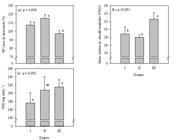ABSTRACT
The objective of this work was to evaluate the quality of seedlings of clone 1528 of eucalyptus after hardening with application of jasmonic acid (JA) and stem bending. The experiment conducted in two stages, the first in protected environment and the second in the field. A completely randomized experimental design with seven treatments (control, 2.0, 4.0, 6.0 and 8.0 μmol L-1 of JA applied weekly for 4 weeks, 20 and 40 daily push-ups for 4 weeks), with five replicates of twenty seedlings. At the end of the treatments, the increase in height (IA), collection diameter (IDC), number of leaves (NF), dry masses of roots and shoot and relative chlorophyll index (SPAD) were determined. At 90 days after planting (field), the increases in height, the collection diameter, and the height / diameter ratio of the seedlings were evaluated. A clustering analysis by UPGMA showed a formation of three groups: group 1 (control, 2.0, 4.0 and 6.0 μmol L-1 of JA); Group 2 (8.0 μmol L-1 of JA) and group 3 (stem bending). Seedlings that showed the greatest increase in height and number of leaves (groups I and II) during the rustification phase obtained to greater increase in height and in the diameter of the field collection at ninety days after planting. Parameters such as increment in collection diameter, root regeneration potential and SPAD quantified during the rustification of seedlings in the nursery are not predictive of higher field performance.
Keywords:
jasmonic acid; caulinary flexures; quality of seedlings; clone 1528

 Thumbnail
Thumbnail
 Thumbnail
Thumbnail
 Thumbnail
Thumbnail
 Thumbnail
Thumbnail
 Thumbnail
Thumbnail




